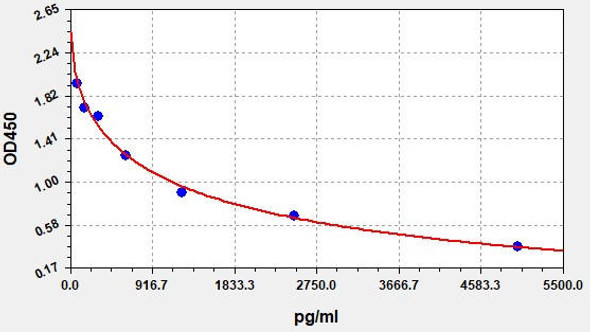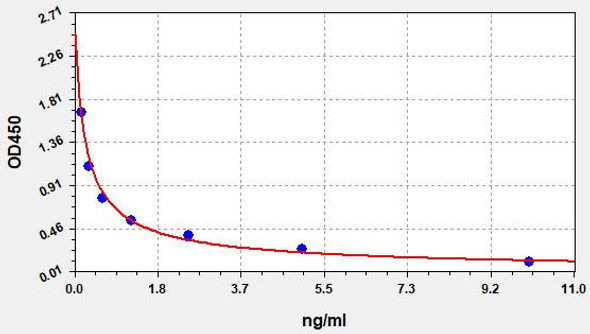Description
Human Neopterin ELISA Kit
Neopterin is a naturally occurring biomarker that plays a vital role in the immune system. It is produced by human monocytes and macrophages in response to the activation of the cellular immune system. Measurement of neopterin levels through an ELISA (Enzyme-Linked Immunosorbent Assay) can provide valuable insights into the immune system's response and aid in disease diagnosis, prognosis, and monitoring. The Assay Genie Human Neopterin ELISA Kit is a highly sensitive assay for the quantitative measurement of Neopterin in serum, plasma, cell and tissue lysates.
Key Features
| Save Time | Pre-coated 96 well plate | |
| Quick Start | Kit includes all necessary reagents | |
| Publication Ready | Reproducible and reliable results |
Overview
| Product Name: | Human Neopterin ELISA Kit |
| Product Code: | HUFI02658 |
| Size: | 96 Assays |
| Alias: | Neopterin |
| Detection Method: | Competitive ELISA, Coated with Antibody |
| Application: | This immunoassay kit allows for the in vitro quantitative determination of Human Neopterin concentrations in serum plasma and other biological fluids. |
| Sensitivity: | 0.094ng/ml |
| Range: | 0.156-10ng/ml |
| Storage: | 4°C for 6 months |
| Note: | For Research Use Only |
Additional Information
| Recovery | Matrices listed below were spiked with certain level of Human Neopterin and the recovery rates were calculated by comparing the measured value to the expected amount of Human Neopterin in samples.
| ||||||||||||||||||||
| Linearity | The linearity of the kit was assayed by testing samples spiked with appropriate concentration of Human Neopterin and their serial dilutions. The results were demonstrated by the percentage of calculated concentration to the expected.
| ||||||||||||||||||||
| CV(%) | Intra-Assay: CV<8% |
Kit Components
| Component | Quantity | Storage |
| ELISA Microplate (Dismountable) | 8x12 strips | 4°C for 6 months |
| Lyophilized Standard | 2 | 4°C/ -20°C |
| Sample/Standard Dlution Buffer | 20ml | 4°C |
| Biotin-labeled Antibody (Concentrated) | 120ul | 4°C (Protection from light) |
| Antibody Dilution Buffer | 10ml | 4°C |
| HRP-Streptavidin Conjugate (SABC) | 120ul | 4°C (Protect from light) |
| SABC Dilution Buffer | 10ml | 4°C |
| TMB Substrate | 10ml | 4°C (Protection from light) |
| Stop Solution | 10ml | 4°C |
| Wash Buffer (25X) | 30ml | 4°C |
| Plate Sealer | 5 | - |
Other materials required:
- Microplate reader with 450 nm wavelength filter
- Multichannel Pipette, Pipette, microcentrifuge tubes and disposable pipette tips
- Incubator
- Deionized or distilled water
- Absorbent paper
- Buffer resevoir
Protocol
*Note: Protocols are specific to each batch/lot. For the correct instructions please follow the protocol included in your kit.
Equilibrate the TMB substrate for at least 30 min at 37°C beforeuse. When diluting samples and reagents, they must be mixed completely andevenly. It is recommended to plot a standard curve for each test.
| Step | Procedure |
| 1. | Set standard, test sample and control (zero) wells on the pre-coatedplate respectively, and then, record their positions. It isrecommended to measure each standard and sample in duplicate. Washplate 2 times before adding standard, sample and control (zero) wells! |
| 2. | Add Sample and Biotin-detection antibody: Add 50µL of Standard, Blank or Sample per well. The blankwell is added with Sample Dilution Buffer. Immediately add 50 µL of biotin-labelled antibody workingsolution to each well. Cover with the plate sealer provided. Gently tap the plate to ensure thoroughmixing. Incubate for 45 minutes at 37°C. (Solutions are added to the bottom of micro-ELISA platewell, avoid touching plate walls and foaming). |
| 3. | Wash: Aspirate each well and wash, repeating the process three timesWash by filling each well with Wash Buffer (approximately 350µL)using a squirt bottle, multi-channel pipette, manifold dispenser orautomated washer. Complete removal of liquid at each step is essentialto good performance. After the last wash, remove any remaining WashBuffer by aspirating or decanting. Invert the plate and pat it againstthick clean absorbent paper. |
| 4. | HRP-Streptavidin Conjugate(SABC): Add 100µL of SABC workingsolution to each well. Cover with a new Plate sealer. Incubate for30minutes at 37°C. |
| 5. | Wash: Repeat the aspiration/wash process for five times. |
| 6. | TMB Substrate: Add 90µL of TMB Substrate to each well. Coverwith a new Plate sealer. Incubate for about 10-20 minutes at 37°C.Protect from light. The reaction time can be shortened or extendedaccording to the actual color change, but not more than 30minutes.When apparent gradient appeared in standard wells, you can terminatethe reaction. |
| 7. | Stop: Add 50µL of Stop Solution to each well. Color turn toyellow immediately. The adding order of stop solution should be as thesame as the substrate solution. |
| 8. | OD Measurement: Determine the optical density (OD Value) of each wellat once, using a microplate reader set to 450 nm. You should open themicroplate reader ahead, preheat the instrument, and set the testing parameters. |
Sample Type
When carrying out an ELISA assay it is important to prepare your samples in order to achieve the best possible results. Below we have a list of procedures for the preparation of samples for different sample types.
| Sample Type | Protocol |
| Serum | If using serum separator tubes, allow samples to clot for 30 minutes at room temperature. Centrifuge for 10 minutes at 1,000x g. Collect the serum fraction and assay promptly or aliquot and store the samples at -80°C. Avoid multiple freeze-thaw cycles. If serum separator tubes are not being used, allow samples to clot overnight at 2-8°C. Centrifuge for 10 minutes at 1,000x g. Remove serum and assay promptly or aliquot and store the samples at -80°C. Avoid multiple freeze-thaw cycles. |
| Plasma | Collect plasma using EDTA or heparin as an anticoagulant. Centrifuge samples at 4°C for 15 mins at 1000 × g within 30 mins of collection. Collect the plasma fraction and assay promptly or aliquot and store the samples at -80°C. Avoid multiple freeze-thaw cycles. Note: Over haemolysed samples are not suitable for use with this kit. |
| Urine & Cerebrospinal Fluid | Collect the urine (mid-stream) in a sterile container, centrifuge for 20 mins at 2000-3000 rpm. Remove supernatant and assay immediately. If any precipitation is detected, repeat the centrifugation step. A similar protocol can be used for cerebrospinal fluid. |
| Cell culture supernatant | Collect the cell culture media by pipette, followed by centrifugation at 4°C for 20 mins at 1500 rpm. Collect the clear supernatant and assay immediately. |
| Cell lysates | Solubilize cells in lysis buffer and allow to sit on ice for 30 minutes. Centrifuge tubes at 14,000 x g for 5 minutes to remove insoluble material. Aliquot the supernatant into a new tube and discard the remaining whole cell extract. Quantify total protein concentration using a total protein assay. Assay immediately or aliquot and store at ≤ -20 °C. |
| Tissue homogenates | The preparation of tissue homogenates will vary depending upon tissue type. Rinse tissue with 1X PBS to remove excess blood & homogenize in 20ml of 1X PBS (including protease inhibitors) and store overnight at ≤ -20°C. Two freeze-thaw cycles are required to break the cell membranes. To further disrupt the cell membranes you can sonicate the samples. Centrifuge homogenates for 5 mins at 5000xg. Remove the supernatant and assay immediately or aliquot and store at -20°C or -80°C. |
| Tissue lysates | Rinse tissue with PBS, cut into 1-2 mm pieces, and homogenize with a tissue homogenizer in PBS. Add an equal volume of RIPA buffer containing protease inhibitors and lyse tissues at room temperature for 30 minutes with gentle agitation. Centrifuge to remove debris. Quantify total protein concentration using a total protein assay. Assay immediately or aliquot and store at ≤ -20 °C |
| Breast Milk | Collect milk samples and centrifuge at 10,000 x g for 60 min at 4°C. Aliquot the supernatant and assay. For long term use, store samples at -80°C. Minimize freeze/thaw cycles. |
Neopterin Background
Neopterin
Neopterin is a pteridine compound with a molecular weight of 253 D, belonging to the class of pteridines. It exists in equilibrium with 7,8-dihydroneopterin, and the presence of both oxidized and reduced forms of pteridin at high concentrations may indicate oxidative stress. Pteridines are chemical compounds consisting of fused pyrimidine and pyrizine rings. Within this structure, pteridines can have various substitutions, resulting in a wide range of heterocyclic compounds. Pterins and flavins, which are substituted pteridines, exhibit significant biological activities. Neopterin is synthesized from guanosine triphosphate (GTP) through γ-interferon (INF-γ) activation of T cells. An increase in neopterin concentration in urine or blood signifies the activation of cellular immunity and the release of INF-γ from endogenous sources.
Neopterin Activation
INF (interferon) activates gene transcription by initiating intracellular signaling through a complex mechanism involving specific cell surface receptors. This INF stimulation modulates the gene, resulting in inhibition of viral replication, cell proliferation, and immunomodulation in infected cells. Neopterin, an effector protein, along with 2',5'-oligoadeylate synthetase, is stimulated by INF. Neopterin has been extensively utilized in INF studies to demonstrate its role in immune activation. Numerous studies have validated neopterin as a reliable marker of INF activation, as its levels increase in response to INF stimulation
Neopterin ELISA Kit FAQs
What is the Neopterin ELISA Kit used for?
The Neopterin ELISA Kit is specifically designed for the quantitative detection of neopterin levels in human samples. Neopterin is a biomarker that has been implicated in various inflammatory and immune-related conditions. This kit allows researchers and healthcare professionals to measure neopterin levels accurately, enabling investigations into the role of neopterin in diagnosing and monitoring diseases such as infections, autoimmune disorders, and certain types of cancer.
What are the advantages of using the Neopterin ELISA Kit?
The Neopterin ELISA Kit offers several advantages, including high sensitivity, accuracy, and reproducibility. It provides a user-friendly and reliable method to quantify Neopterin levels in biological specimens, allowing for precise measurements and robust data analysis.
What sample types are compatible with Neopterin ELISA Kit?
The Neopterin ELISA Kit is compatible with various sample types, including serum, plasma, cell lysates, and tissue homogenates. It provides flexibility in sample selection, allowing researchers to analyze Neopterin levels in different biological matrices.
What are the storage requirements with Neopterin ELISA Kit?
The Neopterin ELISA Kit components should be stored according to the instructions provided in the kit manual. Generally, it is recommended to store the kit components at the recommended temperature to ensure their stability and optimal performance.
What should I do if my assay results are not optimal?
If you encounter any issues or have suboptimal assay results, we recommend contacting our dedicated support team for assistance. They will be available to provide troubleshooting guidance, answer your questions, and ensure you achieve the best possible results with the Neopterin ELISA Kit.







